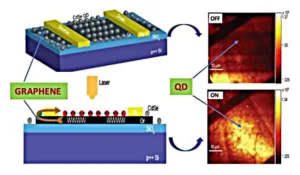A team of researchers within the Department of Physics at the Indian Institute of Science (Bangalore, India) or IISc has created a novel hybrid material composed of graphene and quantum dots. The new material has the potential to enable future high efficiency, electrically controllable displays and LEDs.
A recent article on this subject published by the team, led by Jaydeep Kumar Basu, is entitled “Electrically Tunable Enhanced Photoluminescence of Semiconductor Quantum Dots on Graphene.” It was published in ACS Photonics, 2017, 4 (8), pp 1967–1973. A copy of the article is available for purchase here.
Here is some background information.
Quantum dots are extremely tiny particles of semiconductor material that can absorb UV light and emit bright, narrow bandwidth visible light. The color of the light emitted by the quantum dot depends on the size of the dot. Small dots emit blue light while large ones emit red light. The dots absorb light very effectively but are poor electrical conductors. As a consequence, they cannot efficiently convert light into electricity. It further follows that, by themselves, quantum dots are not suitable as the basis of display devices.
Next, consider graphene. Graphene has weak and wavelength independent absorption and no emission in the visible range. It is an excellent electrical conductor.
To improve the efficiency of devices, researchers have tried to create a synergistic effect between quantum dots and graphene. The idea is that, when the two are combined, graphene would quickly pull the absorbed energy away from the quantum dots. This would minimize energy loss while also converting the energy into an electrical signal.
As a practical matter, it is found that the combination works well for photodetectors and sensors, but not for displays and LEDs. The reason is that “strong nonradiative energy transfer between quantum dot emitters and graphene makes it impossible to create such devices due to strong emission quenching.” In other words, “Graphene acts like a sponge, as far as the quantum dots are concerned. It does not allow any emission.”
This is the issue addressed by the IISc researchers. The researchers found a way to overcome this “quenching” effect by bringing into play a phenomenon called superradiance. “When individual atoms or emitters (such as quantum dots) in a layer are excited, each one emits light independently. Under certain conditions, all the atoms or emitters can be made to emit light cooperatively. This overcomes the strong nonradiative quenching previously observed and produces a very bright light, with an intensity significantly greater than the sum total of individual emissions.”
In previous research, the team was able to create experimental conditions that brought about superradiance in a thin layer of quantum dots by combining them with metal nanoparticles. The team has recreated those conditions in the new quantum dot-graphene hybrid devices to produce superradiance. The result is reported as strong enough to overcome the quenching effect.
The researchers determined the regime over which superradiance effect is likely to dominate by using a technique called finite difference time domain simulation. More specifically, it was determined that the effect dominates when individual quantum dots are 5 nm or less apart and the quantum dot layer and graphene are separated by a distance of 3 nm or less. The figure below illustrates the configuration of the device.
The configuration of the quantum dot – graphene device.
When superradiance dominates, the intensity of light emitted in the presence of the graphene was found to be three times higher than what could have been achieved using quantum dots alone. In addition, “The advantage with graphene is that you can also tune it electrically. You can vary the intensity by simply changing the voltage or the current.”
In their recent article, the team comments that the results open up “new avenues for research on understanding study fundamental aspects of electrically tunable light-matter interactions at the nanoscale.” This, in turn, may open up “new avenues for research on novel displays, lasers and emissive devices involving graphene-quantum dot hybrids.” -Arthur Berman
Indian Institute of Science, Jaydeep Kumar Basu, [email protected]

